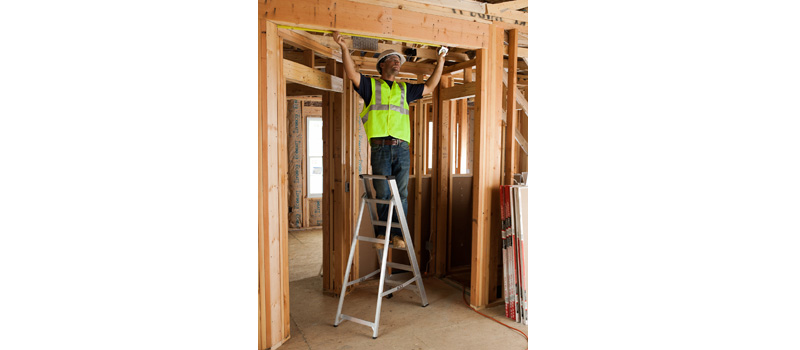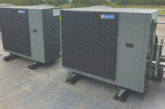
David Shrimpton, Ladder Association trainer at Werner, explains that a little care goes a long way when it comes to working at height.
Seasoned professionals will know that safety first is essential to guard against falls from height, which could result in injury, loss of earnings – and even death.
Even if you’ve done it all before, going back to basics is a healthy habit, especially where pressing deadlines can easily lead to the best of us taking our eye off the ball.
The majority of accidents are preventable if you think before you climb. Taking a few minutes to assess the situation can save your time and your health in the long run, which is essential when your livelihood depends on being physically fit.
Here’s our five-step checklist:
Am I trained for the task?
Is the ladder inspection labelled and in date?
Is it a good ladder?
Does the job look too dangerous?
Have I remembered how to use a ladder safely?
Use the right ladder for the job
Always select the correct ladder for the job. Check the type of product, the working height required, and the maximum safe working load shown by the symbol. Think about your environment too – for example, when working near electricity, it’s highly recommended to use a fibreglass ladder due to their non-conductive stiles.
From extension ladders to work platforms, the equipment you choose should meet the required British standards. For trade, choose BS 2037 Class 1 Industrial or BS EN131 Light Trade ladders, with maximum vertical loads of 175kg and 150kg respectively. Don’t use BS 2037 Class 3 Domestic ladders for trade or industrial applications.
Equally important is using a ladder of the correct height for the job at hand. Some are too short for high work, and some – just as dangerous – are too tall for lower work. You must be able to do your work comfortably without overreaching upwards, downwards or sideways. If you’re not sure which product to choose, try an online tool like the Werner Ladder Selector which allows you to match the ladder height and style to the application, helping you find the right product for your needs.
Safety before you climb
Have your ladder inspected from new by a competent person and tagged according to the statutory requirements of the Provision and Use of Work Equipment Act.
Check that working parts move properly and that all connections are secure, particularly around the spreaders, extension ladder rung hooks and locking catches, ropes and safety feet. Also check for missing, damaged or loose components. Never use a damaged ladder.
Read the instructions and warnings every time. Failure to follow them may result in serious injury or death.
Care for your ladder by cleaning spills or drips and keeping it free from oil, paint and other slippery materials. Lightly lubricate moving parts.
Stored ladders should be kept out of the reach of children. When not in use, protect ladders from excessive heat, corrosive atmosphere and general weather conditions.
If fibreglass ladders are being transported on a roof rack clamp, ensure the clamp is not over tightened as this may cause damage to the ladder stiles.
When carrying the ladder, hold it in a vertical position if at all possible.
Using your ladder correctly
Fully open the stepladder and firmly lock both spreaders.
Ensure clutches are fully engaged on extension ladders.
Position the ladder so you can face your work and do not have to lean sideways.
Be sure that all ladder feet are on firm ground. If you need to level up the ladder, use a compatible leveling device rather than bits of wood or bricks. Don’t place a ladder on slippery surfaces.
Place the extension ladder top so both stiles are fully supported. Support area should be at least 300mm wide on both sides of the ladder.
Use fibreglass ladders if there is even a remote possibility of working near electricity or overhead power lines. Fibreglass stiles are electrically non-conductive.
Place an extension ladder at a 75 degree angle. The set-back (“S”) needs to be 1m away from the building for every 4m of length (“L”) to the upper support point.
Do
Set-up the ladder properly in accordance with safety instructions and warnings.
Wear fully enclosed shoes with non-slip soles.
Keep your body centred on the ladder, and never overreach.
Maintain three points of contact with the ladder.
Use extra caution when carrying anything on the ladder. Remember, the load rate of the ladder includes the weight of the user and materials.
Climb facing the ladder. Centre your body between stiles, maintain a firm grip, and always move one step at a time.
Ask another person to help carry ladders 2.5 meters or longer.
Get someone to hold the ladder while you are working on it.
Don’t
Stand or sit on a stepladder top. You could easily lose your balance or tip the ladder.
Climb a closed stepladder.
Climb on the back of a stepladder, it may slip out from under you.
Climb a ladder if you are not physically and mentally up to the task, e.g. if you’re tired or have been drinking alcohol.
Place the base of an extension ladder too close to or too far away from the building.
Overreach, lean to one side or try to move a ladder while on it. Climb down and then reposition the ladder closer to your work.
Exceed the maximum load capacity or duty rating of a ladder.
Let more than one person on a single-sided stepladder or an extension ladder.
For help selecting the right ladder or to download a safety check sheet, visit www.uk.wernerco.com.













